NCERT Solutions for Class 8 Maths Chapter 2 Exercise 2.2 – Linear Equation in one variable, has been designed by the NCERT to test the knowledge of the student on the topic – Some Applications of Linear Equation in one variable
NCERT Solutions for Class 8 Maths Chapter 2 Exercise 2.2 – Linear Equation in one variable
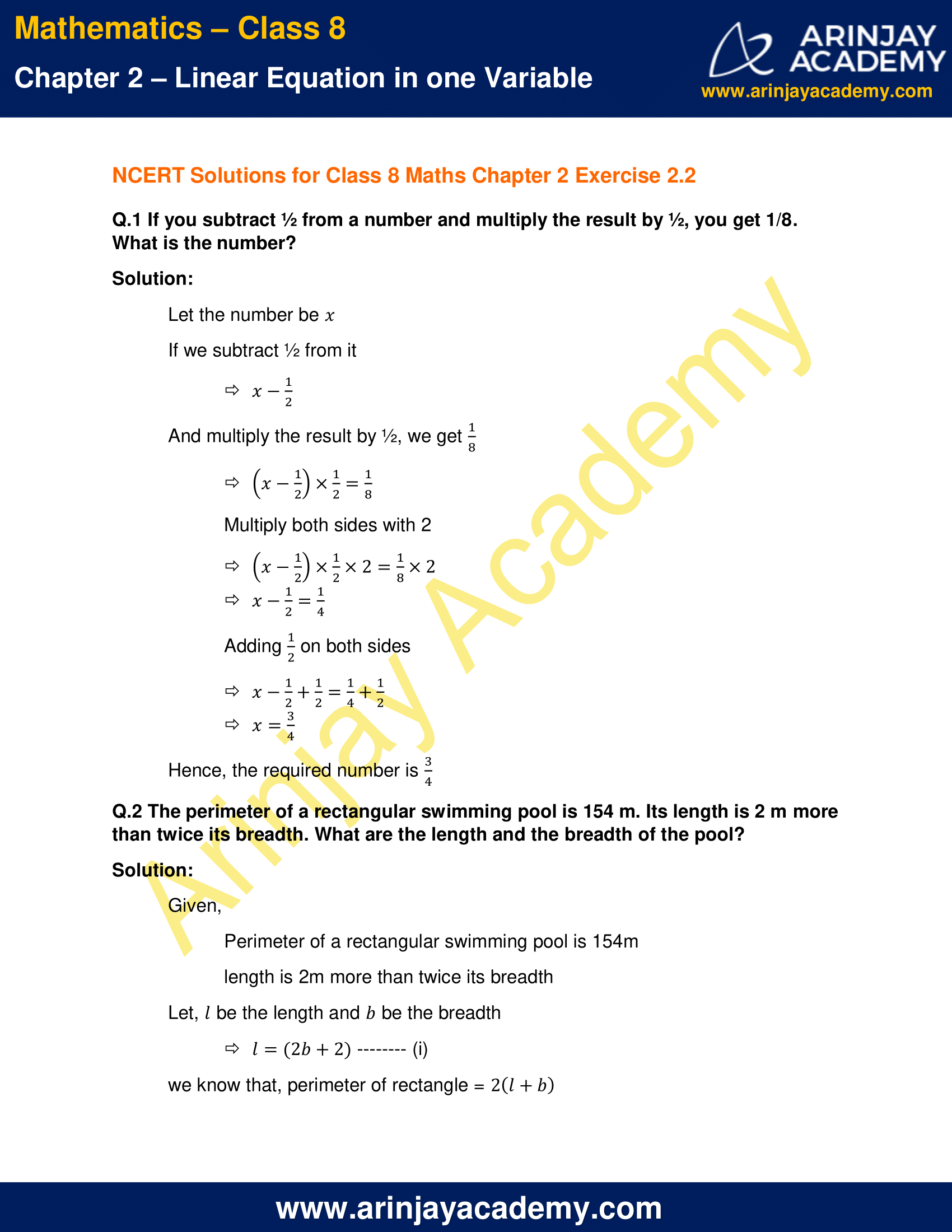

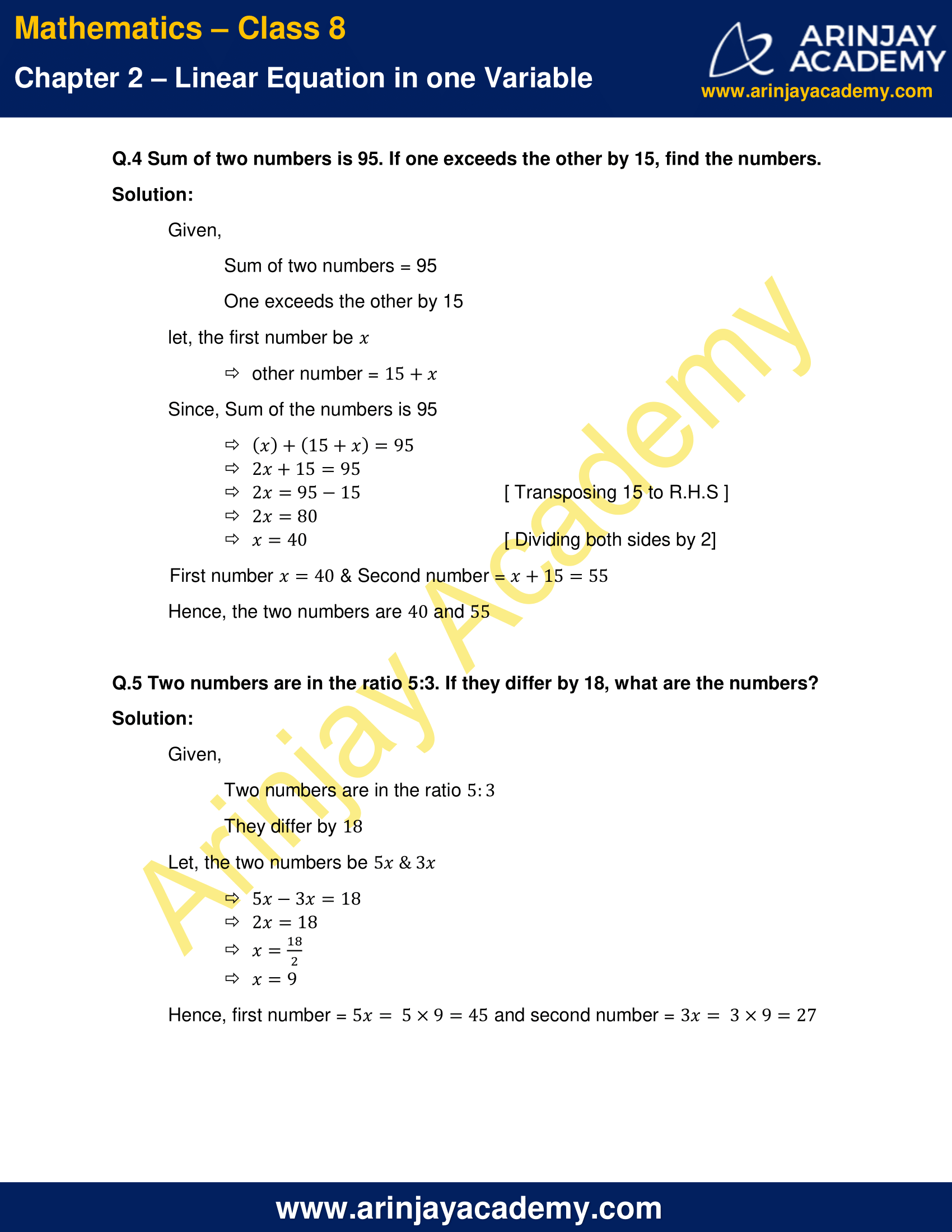
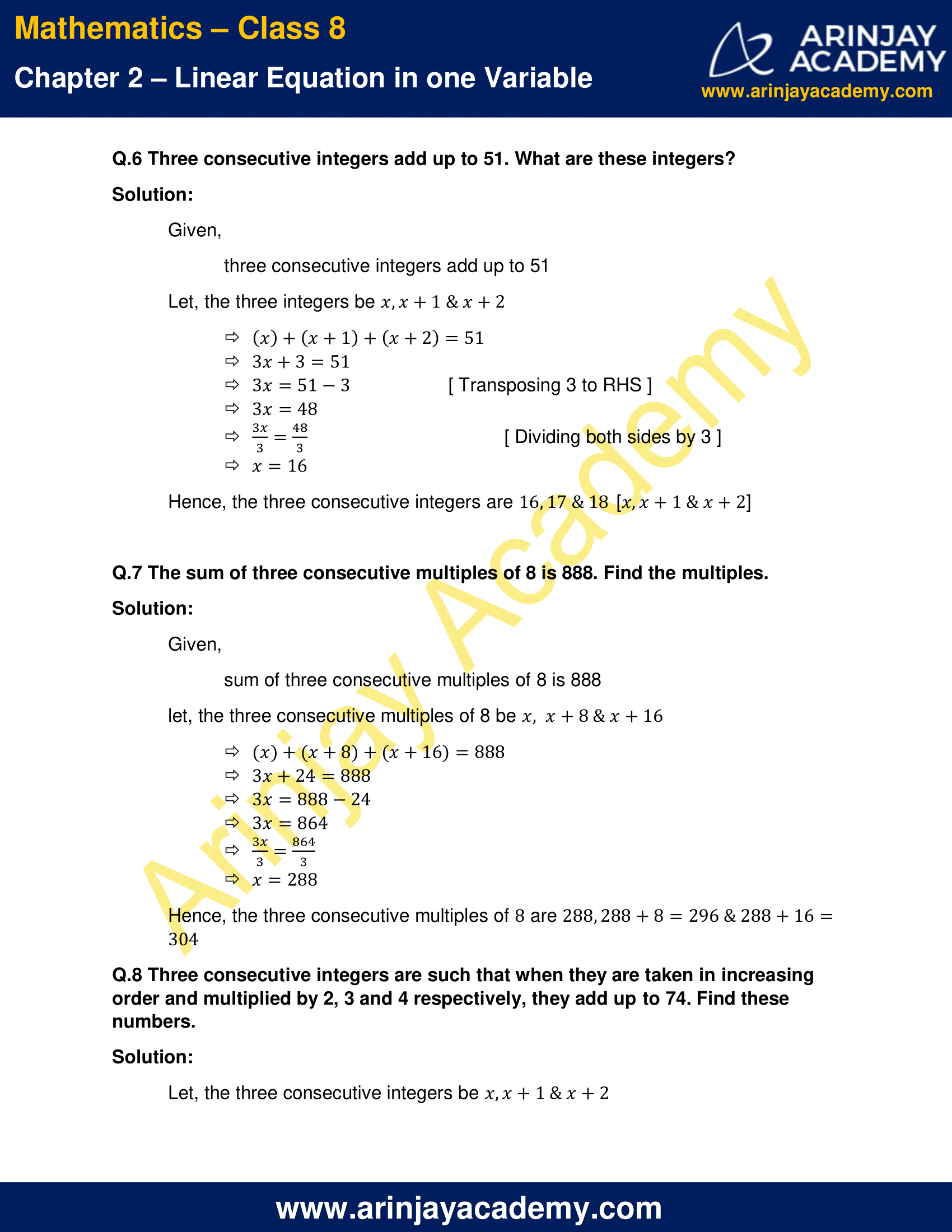
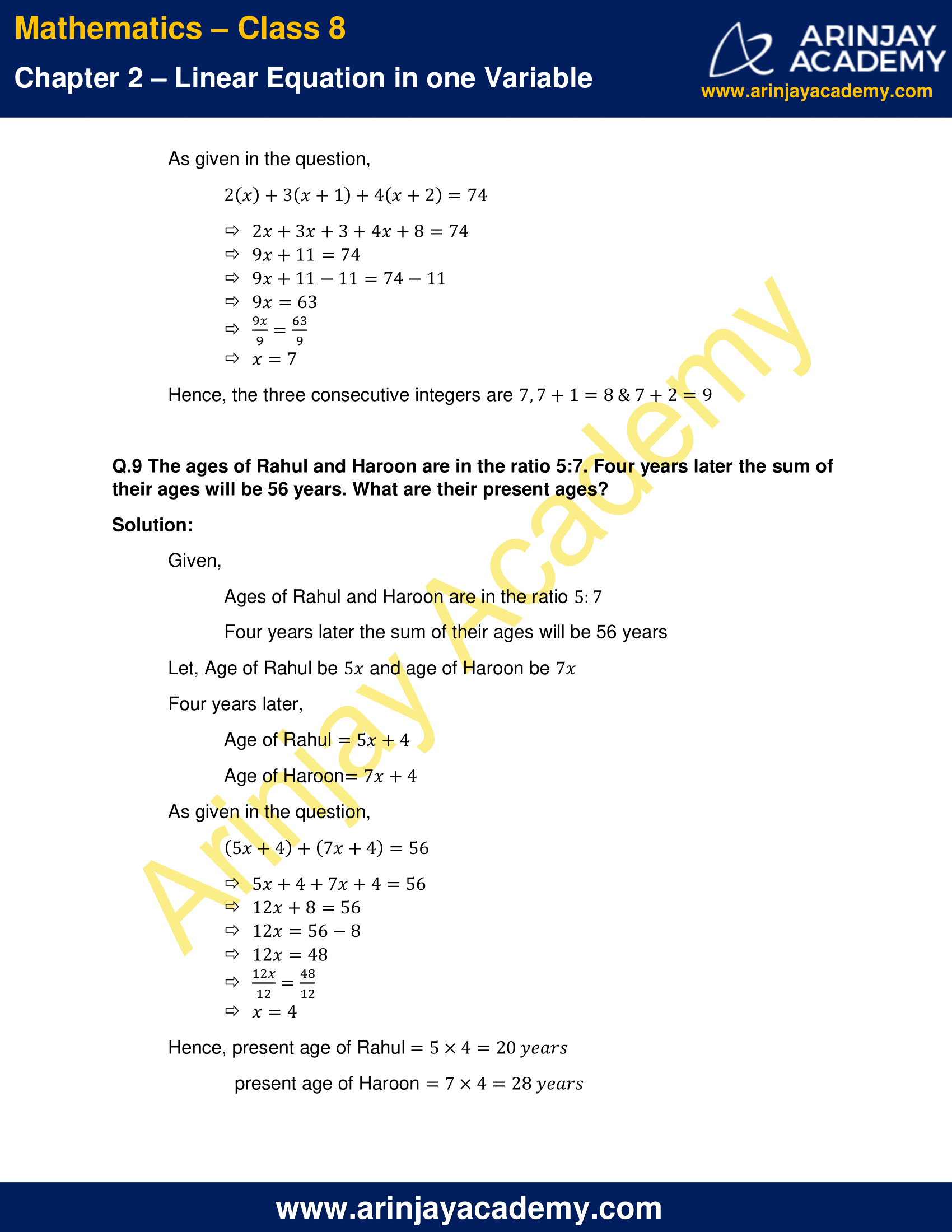
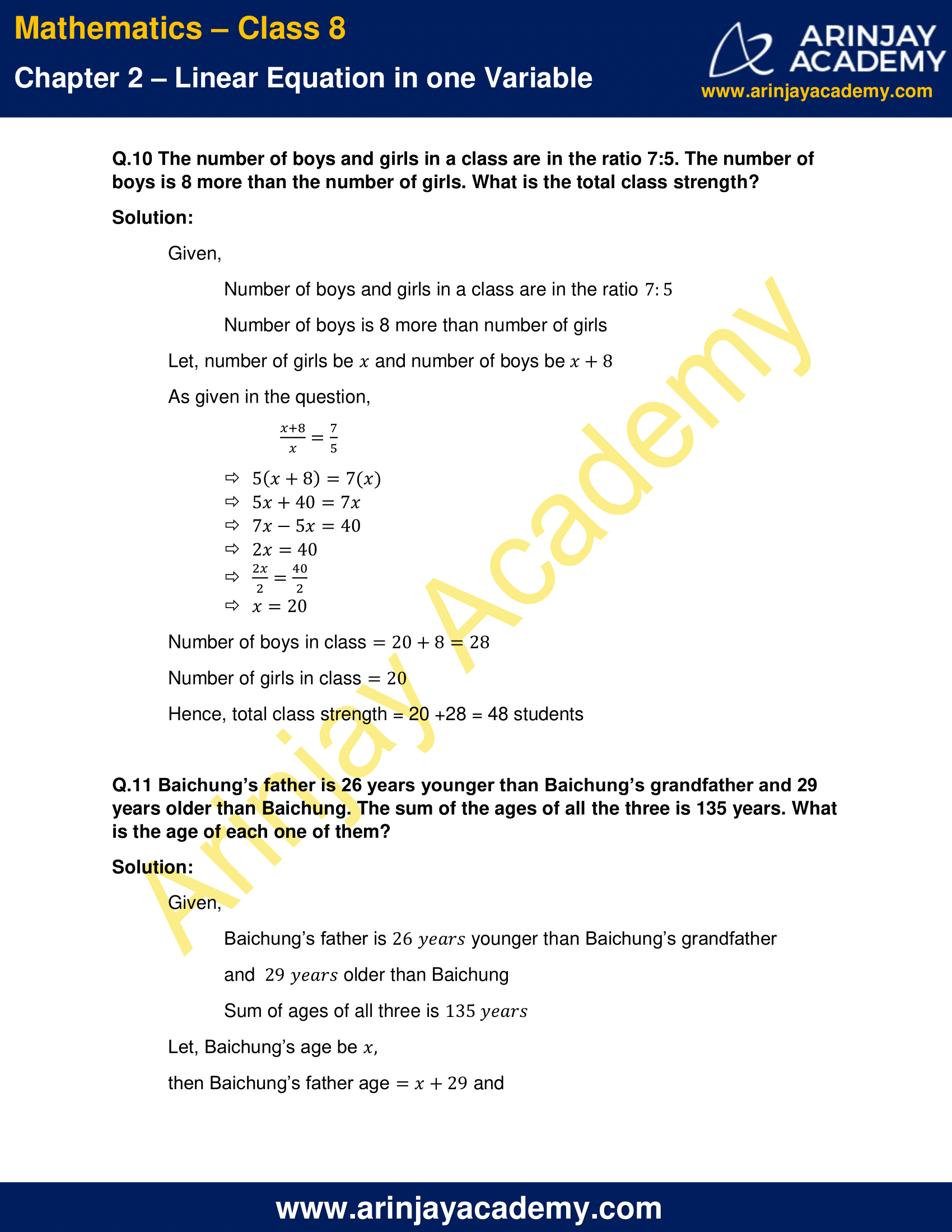


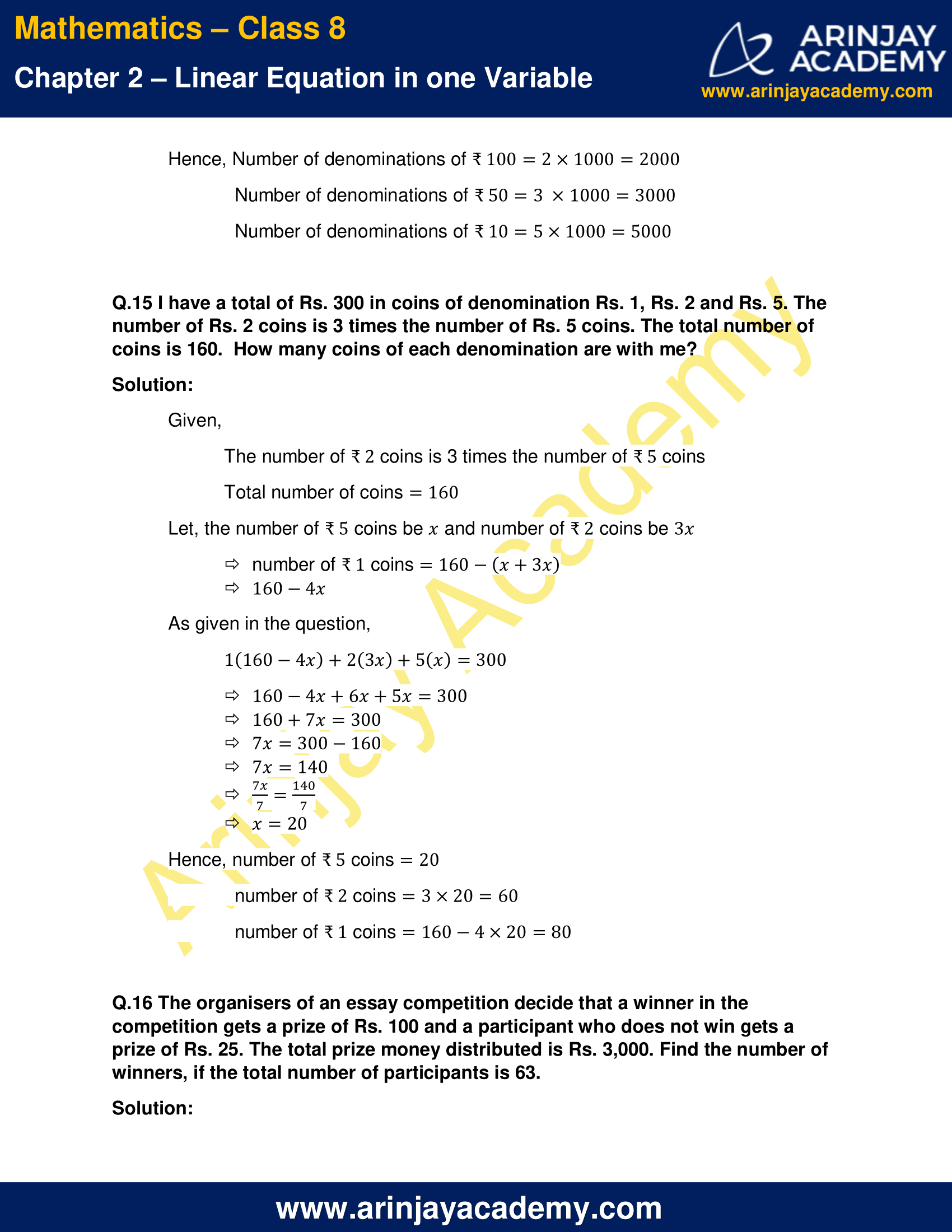
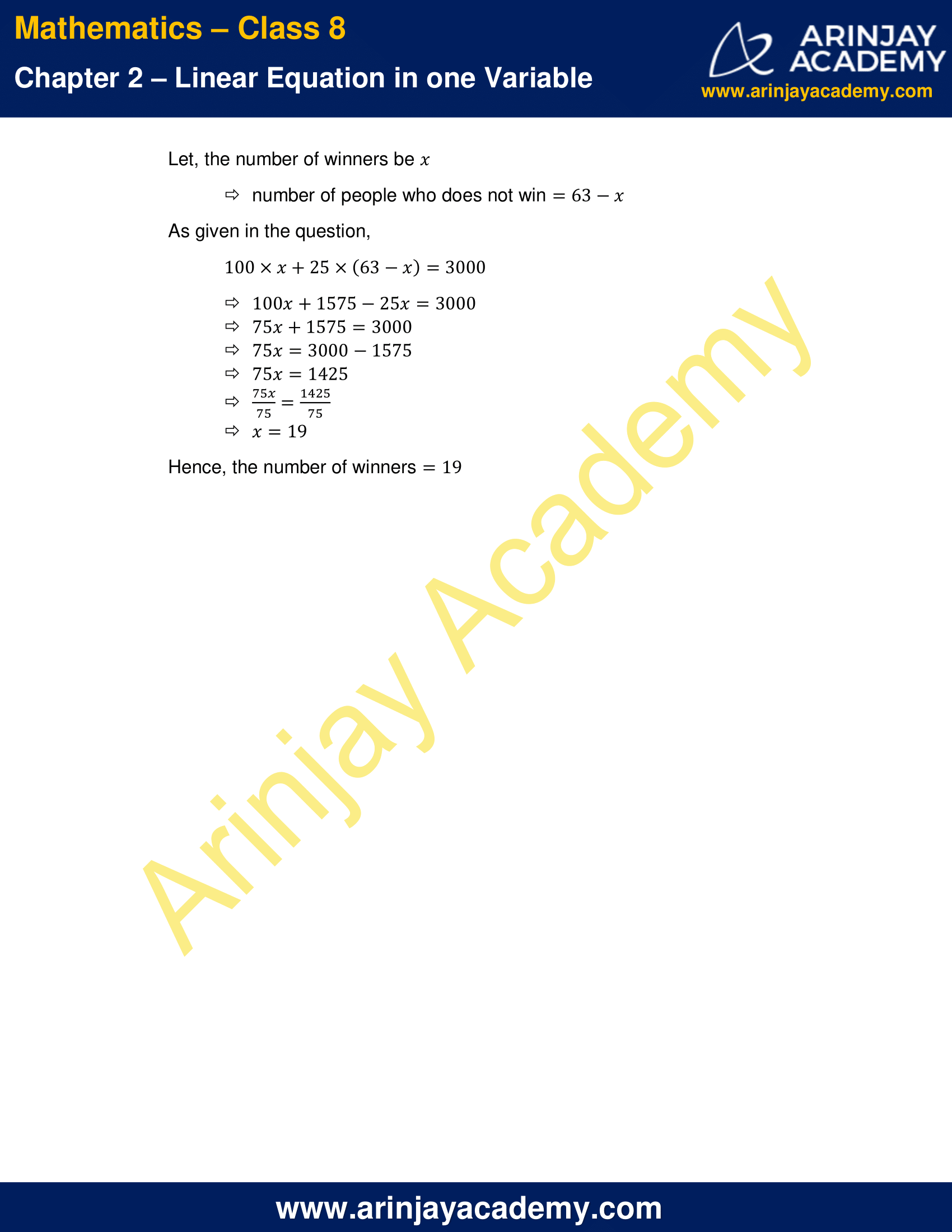
NCERT Solutions for Class 8 Maths Chapter 2 Exercise 2.2 – Linear Equation in one variable
Q.1 If you subtract (1/2) from a number and multiply the result by (1/2), you get (1/8). What is the number?
Solution:
Let the number be ‘x’
If we subtract (1/2) from it
x – (1/2)
And multiply the result by (1/2), we get (1/8)
[x – (1/2)] × (1/2) = (1/8)
Multiply both sides with 2
[x – (1/2)] × (1/2) × 2 = (1/8) × 2
x – (1/2) = (1/4)
Adding (1/2) on both sides
x – (1/2) + (1/2) = (1/4) + (1/2)
x = (3/4)
Hence, the required number is (3/4)
Q.2 The perimeter of a rectangular swimming pool is 154 m. Its length is 2 m more than twice its breadth. What are the length and the breadth of the pool?
Solution:
Given,
Perimeter of a rectangular swimming pool is 154m
length is 2m more than twice its breadth
Let, l be the length and b be the breadth
l=(2b+2) ——– (i)
we know that, perimeter of rectangle = 2(l+b)
2(l+b)=154—–(ii)
Replacing l with 2b+2 we get
2(2b+2+b)=154
2(3b+2)=154
6b+4=154
6b=154-4
6b=150
b=(150/6)
b=25m
Putting value of b in (i)
l=(2(25)+2)
l=52m
Hence length of pool is 52m and breadth of pool is 25m.

Solution:
Given,
Base of an isosceles Triangle = (4/3) cm



2x = (62/15) – (4/3) [ Transposing (4/3) to R.H.S ]
2x = 42/15
x = 21/15
x = (7/5) cm
Hence, length of either of the remaining equal sides = (7/5) cm
Q.4 Sum of two numbers is 95. If one exceeds the other by 15, find the numbers.
Solution:
Given,
Sum of two numbers = 95
One exceeds the other by 15
let, the first number be ‘x’
other number = 15+x
Since, Sum of the numbers is 95
(x)+(15+x)=95
2x+15=95
2x=95-15 [Transposing 15 to R.H.S]
2x=80
x=40 [ Dividing both sides by 2]
First number x = 40 & Second number = x + 15 = 55
Hence, the two numbers are 40 and 55
Q.5 Two numbers are in the ratio 5:3. If they differ by 18, what are the numbers?
Solution:
Given,
Two numbers are in the ratio 5:3
They differ by 18
Let, the two numbers be 5x & 3x
5x-3x=18
2x=18
x= 18/2
x=9
Hence, first number = 5x = 5 × 9=45 and second number = 3x = 3 × 9 = 27
Q.6 Three consecutive integers add up to 51. What are these integers?
Solution:
Given,
three consecutive integers add up to 51
Let, the three integers be x, x+1 and x+2
(x)+(x+1)+(x+2)=51
3x+3=51
3x=51-3 [ Transposing 3 to RHS ]
3x=48
3x/3 = 48/3 [ Dividing both sides by 3 ]
x = 16
Hence, the three consecutive integers are 16, 17, 18 [x, x+1 and x+2]
Q.7 The sum of three consecutive multiples of 8 is 888. Find the multiples.
Solution:
Given,
Sum of three consecutive multiples of 8 is 888
Let, the three consecutive multiples of 8 be (x, x+8 and x+16)
(x)+(x+8)+(x+16)=888
3x+24=888
3x=888-24
3x=864
3x/3 = (864/3)
x = 288
Hence, the three consecutive multiples of 8 are (288, 288+8=296 and 288+16=304)
Q.8 Three consecutive integers are such that when they are taken in increasing order and multiplied by 2, 3 and 4 respectively, they add up to 74. Find these numbers.
Solution:
Let, the three consecutive integers be (x, x+1 and x+2)
As given in the question,
2(x)+3(x+1)+4(x+2)=74
2x+3x+3+4x+8=74
9x+11=74[/latex]
9x+11-11=74-11[/latex]
9x=63[/latex]
9x/9 = 63/9
x = 7
Hence, the three consecutive integers are 7, 7+1=8 & 7+2=9
Q.9 The ages of Rahul and Haroon are in the ratio 5:7. Four years later the sum of their ages will be 56 years. What are their present ages?
Solution:
Given,
Ages of Rahul and Haroon are in the ratio 5:7
Four years later the sum of their ages will be 56 years
Let, Age of Rahul be 5x and age of Haroon be 7x
Four years later,
Age of Rahul = 5x+4
Age of Haroon = 7x+4
As given in the question,
(5x+4) + (7x+4) = 56
5x+4+7x+4=56
12x+8=56
12x=56-8
12x=48
12x/12 = 48/12
x=4
Hence, present age of Rahul = 5 x 4 = 20 years
present age of Haroon = 7 x 4 = 28 years
Q.10 The number of boys and girls in a class are in the ratio 7:5. The number of boys is 8 more than the number of girls. What is the total class strength?
Solution:
Given,
Number of boys and girls in a class are in the ratio 7:5
Number of boys is 8 more than number of girls
Let, number of girls be ‘x’ and number of boys be ‘x+8’
As given in the question,
x+8/x = 7/5
5(x+8)=7(x)
5x+40=7x
7x-5x=40
2x=40
2x/2 = 40/2
x=20
Number of boys in class = 20+8 = 28
Number of girls in class = 20
Hence, total class strength = 20 +28 = 48 students
Q.11 Baichung’s father is 26 years younger than Baichung’s grandfather and 29 years older than Baichung. The sum of the ages of all the three is 135 years. What is the age of each one of them?
Solution:
Given,
Baichung’s father is 26 years younger than Baichung’s grandfather and 29 years older than Baichung
Sum of ages of all three is 135 years
Let, Baichung’s age be x
then Baichung’s father age x+29 and
Baichung’s grandfather age = (x+29) + 26 = x+55
As given in the question,
x+(x+29)+(x+55)=135
3x+29+55=135
3x+84=135
3x=135-84
3x=51
(3x/3) = (51/3)
x = 17years
Hence, Age of Baichung = 17 years
Age of Baichung’s father = 17 + 29 = 46 years
Age of Baichung’s grandfather = 17 + 29 + 26 = 72 years
Q.12 Fifteen years from now Ravi’s age will be four times his present age. What is Ravi’s present age?
Solution:
Given,
Fifteen years from now Ravi’s age will be four times his present age
Let, Ravi’s present age be x
age after fifteen years will be x+15
As given in the question,
(x+15)=4(x)
4x=x+15
3x=15
(3x/3) = (15/3)
x=5
Hence, Ravi’s present age is 5 years
Q.13 A rational number is such that when you multiply it by (5/2) and add (2/3) to the product, you get (-7/12) . What is the number?
Solution:
Given,
A rational number is such that when you multiply it by (5/2) and add (2/3) to the product, the result will be (-7/12)
Let, the rational number be x
[x × (5/2)]+ (2/3) = (-7/12)
(5x/2) + (2/3) = (-7/12)
(5x)/2 = (-7/12) – (2/3)
5x/2 = (-7-8)/12
5x/2 = (-15/12)
x = (-15/12) × (2/5)
x = (-1/2)
Hence, the rational number is (-1/2)
Q.14 Lakshmi is a cashier in a bank. She has currency notes of denominations Rs. 100, Rs. 50 and Rs. 10, respectively. The ratio of the number of these notes is 2:3:5. The total cash with Lakshmi is Rs. 4,00,000. How many notes of each denomination does she have?
Sol:
Let, number of Rs.100, Rs.50 & Rs.10 notes be 2x, 3x and 5x respectively
As given in question,
100(2x)+50(3x)+10(5x)=400000
200x+150x+50x=400000
400x=400000
(400x/400) = (400000/400)
x=1000
Hence, Number of denominations of ₹100=2×1000=2000
Number of denominations of ₹ 50=3 ×1000=3000
Number of denominations of ₹ 10=5×1000=5000
Q.15 I have a total of Rs. 300 in coins of denomination Rs. 1, Rs. 2 and Rs. 5. The number of Rs. 2 coins is 3 times the number of Rs. 5 coins. The total number of coins is 160. How many coins of each denomination are with me?
Solution:
Given,
The number of ₹ 2 coins is 3 times the number of ₹ 5 coins
Total number of coins = 160
Let, the number of ₹ 5 coins be x and number of ₹ 2 coins be 3x
number of ₹ 1 coins = 160 – (x+3x)
= 160-4x
As given in the question,
1(160-4x)+2(3x)+5(x)=300
160-4x+6x+5x=300
160+7x=300
7x=300-160
7x=140
(7x/7) = (140/7)
x=20
Hence, number of ₹ 5 coins = 20
number of ₹ 2 coins = 3 x 20 = 60
number of ₹ 1 coins = 160 – 4 × 20 = 80
Q.16 The organisers of an essay competition decide that a winner in the competition gets a prize of Rs. 100 and a participant who does not win gets a prize of Rs. 25. The total prize money distributed is Rs. 3,000. Find the number of winners, if the total number of participants is 63.
Solution:
Let, the number of winners be x
number of people who does not win 63 – x
As given in the question,
100×x+25×(63-x)=3000
100x+1575-25x=3000
75x+1575=3000
75x=3000-1575
75x=1425
(75x/75) = (1425/75)
x=19
Hence, the number of winners = 19
The next Exercise for NCERT Solutions for Class 8 Maths Chapter 2 Exercise 2.3 – Linear Equation in one variable can be accessed by clicking here
Download NCERT Solutions for Class 8 Maths Chapter 2 Exercise 2.2
